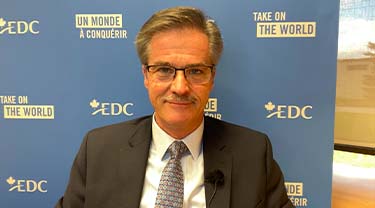As if the pandemic didn’t give us enough insomnia, other worries are robbing Canadian exporters of sleep these days. In Export Development Canada’s (EDC) fall executive roundtable series, we asked our key customers to share their concerns and they weren’t shy. Here’s a list of the top issues they and many others are facing, together with observations on the issues and possible remedies.
Issue No. 1: Bar none is supply chain constraints. Of all the issues raised, this one dominated, gobbling up 35% of the discussion space. And no wonder—it’s been more than a decade since we’ve seen logjams at ports and shortages of ships and containers that seem as rare as gold these days. Not to mention, the difficulty sourcing specific raw commodities and intermediate goods, notably semiconductors. Attendees were very candid in their assessment of the state of global supply chains, with some referring to them as “entirely messed up.”
How did things unwind so badly? Remember, global supply chains have been refined over decades to be a finely tuned, complex machine, spanning the far reaches of the planet. The pandemic’s imprecise pounce on one market after another in no expected order or sequence threw the system into chaos, and the restart was arguably more disorderly. Add further waves of unsynchronized pandemic-come-lockdowns, and the mayhem is magnified multifold. It’s such a muddle that many can’t see a point of resolution until possibly mid-2022. Initially, there was enough capacity to manage things, but with growth continuing to barrel on and fundamentals suggesting hot demand can continue for some time, demand may well outpace our ability to satisfy it.
Issue No. 2: Labour constraints. Fully 20% of the responses from our audiences cited tight access to labour as a key problem, and there was a lot of discussion about remedies. This is nothing new—it was a prime issue when the Advisory Council on Economic Growth reported on it in 2017. If anything, COVID-19 gave some needed respite on this front, and we’re now back to addressing a more structural fault in the economy. Possible remedies were discussed in detail in my Oct. 21 commentary.
Issue No. 3: Inflation—at 18% of issues raised—is another big worry keeping exporters up at night. Attendees were perplexed that shortages were leading to price hikes well beyond acceptable limits, and were agonizing over how to pass these costs on. Others shared that the mindset had shifted so quickly that passing on large increases was a snap. It became clear that businesses haven’t really had to think about inflation for about three decades, but that price expectations were now changing rapidly. Rolling up the results of an informal poll taken at each of our 14 events, attendees expect next year’s consumer price inflation to average somewhere around 3.7%, well above target levels and in excess of the 3.4% estimate in the Bank of Canada’s latest Monetary Policy Report. Most did expect things to settle down as shortages are resolved, but they’re also aware that price changes, together with labour shortages, were starting to push wage demands up, something that may persist longer.
Issue No. 4: Specific country issues always crop up in our discussions, with the bulk focusing on the U.S. economy, but also a range of other concerns, depending on where exporters are doing business and encountering challenges.
Issue No. 5: Volatile commodity prices, uncertainty about monetary policy and recent currency movements made foreign exchange predictions the next item on the concern list. Fears of a commodity supercycle are spilling over into near-future currency worries, and inflation is feeding concern that faster rate hikes north of the border will only push the loonie higher. Temporary supply issues are, indeed, having that effect. When we get beyond that, the currency should calm down. Delegates hoped we’re right, but maybe not convinced by the reasoning.
Other issues lower on the list include:
- pandemic-specific effects;
- travel restrictions;
- access to capital; and
- concerns about the future of the energy sector and how policy will affect the balance of investment in the sector.
The bottom line?
One issue that wasn’t worrisome was growth. Nobody at our events expressed concern that growth was too low, or was about to ebb. That’s great news. All of the issues really seemed to centre around managing the explosive growth we’re currently seeing. Nice problem to have—but it’s a problem, and one that needs a lot of creativity to resolve. Let’s get to it!
This commentary is presented for informational purposes only. It’s not intended to be a comprehensive or detailed statement on any subject and no representations or warranties, express or implied, are made as to its accuracy, timeliness or completeness. Nothing in this commentary is intended to provide financial, legal, accounting or tax advice nor should it be relied upon. EDC nor the author is liable whatsoever for any loss or damage caused by, or resulting from, any use of or any inaccuracies, errors or omissions in the information provided.






